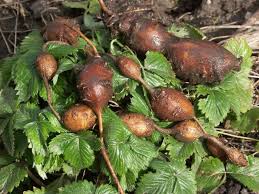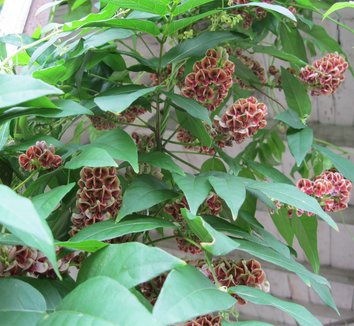Groundnut, Apios americana, sometimes called the potato bean, Indian potato, potato pea, pig potato, bog-potato, wild bean, wild sweet potato, America-hodoimo, hopniss is a perennial vine that bears edible beans and large edible tubers. Its vine can grow to 3-20 long, with leaves 4 to 9 inches long with 1-3 leaflets. The flowers are usually pink, purple, or red-brown. The fruit is a legume (pod) 2 to 3 inches long.
It is a vigorous vine that can wrap itself around shrubs, small trees, and larger vines. It also grows across low vegetation and open ground. The vines can grow from ten to twenty feet each season, dying back in the fall….hopniss plant has several edible parts. The flowers are fairly good raw or cooked, and the seeds are edible…but the most important edible part …Hopniss tubers range from the size of a grape to the size of a grapefruit. Normally they are about one inch thick, one and a half inches long, and egg-shaped.
Its natural range is from Southern Canada (including Ontario, Quebec, and New Brunswick) down through Florida and West as far as the Great Plains.

The tubers are highly palatable with culinary characteristics of a potato, although the flavor can be somewhat nuttier than a potato and the texture can be finer
Tubers contain roughly three times the protein content of a potato, but are not a complete source of amino acids. Thirty-six percent of the fresh weight of a tuber is carbohydrate (primarily starch). The tubers are also an excellent source of calcium and iron.
The tubers were a staple food among most Native American within the range of the plant. In 1749, the travelling Swedish botanist Peter Kalm writes, “Hopniss or Hapniss was the Indian name of a wild plant, which they ate at that time. The roots resemble potatoes, and were boiled by the Indians who ate them instead of bread.”
The American groundnut or hopniss was an important factor in the survival of the Pilgrims during the first few winters of their settlement. In 1623, the Pilgrims, “having but a small quantity of corn left,” were “forced to live on groundnuts… and such other things that the country afforded… and were easily gotten.” It seems quite probable that groundnut would have been eaten at the harvest festival of November 1621 the first Thanksgiving, although only venison was specifically named as a food item at this meal by an eyewitness account.
Groundnuts can be dug at any time of the year, unless the ground is frozen solid. Groundnuts are available in the early spring when starch is hard to find. The tubers can be as much as 8 inches under the ground, although usually less.
The best tubers are medium-sized, young, very firm, and as smooth as you can find them. In a good patch, you can harvest half a bushel in a couple of hours.
It is advisable to cook hopniss before consumption, since it contains trypsin inhibitors and this renders it more digestible. Poorly cooked hopniss, like beans, can cause horrendous gas.
Howard


i like the difinition
I just dug some from my garden today,will be trying them for the first time tomorrow.I love the flowers every year,and they smell like grape koolaid,yum
where can I buy seeds or plants?